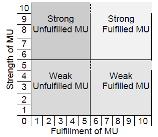Self-perceived quality-of-life scale
Self-perceived Quality-of-Life Scale is a psychometric tool designed to assess the quality of life from the perspective of the individuals themselves. This scale allows respondents to evaluate various aspects of their life, including physical health, psychological state, level of independence, social relationships, personal beliefs, and their relationship to salient features of their environment. The concept of self-perceived quality of life is crucial in fields such as healthcare, psychology, and social sciences, where understanding an individual's subjective well-being is essential for diagnosis, treatment planning, and policy development.
Overview[edit | edit source]
The Self-perceived Quality-of-Life Scale is based on the premise that quality of life is a subjective experience that can be best reported by the individuals experiencing it. This contrasts with objective measures of quality of life, which may rely on indicators such as income, employment status, or health status. The scale typically consists of a series of statements or questions that respondents rate according to their own experiences and perceptions. These ratings are then used to generate a score that reflects the individual's overall quality of life.
Development and Use[edit | edit source]
The development of the Self-perceived Quality-of-Life Scale involves rigorous psychometric testing to ensure its reliability and validity. This process includes determining the scale's ability to consistently measure what it is intended to measure (reliability) and its effectiveness in accurately reflecting the quality of life (validity). Once developed, the scale can be used in a variety of settings, including clinical practice, research studies, and public health surveys.
Components[edit | edit source]
The Self-perceived Quality-of-Life Scale typically addresses several key domains:
- Physical Health: Assessments of pain and discomfort, energy and fatigue, sleep and rest.
- Psychological: Evaluations of positive and negative feelings, self-esteem, cognition, and overall psychological well-being.
- Level of Independence: Measures of mobility, activities of daily living, dependence on medicinal substances and medical aids.
- Social Relationships: Assessments of personal relationships, social support, and sexual activity.
- Environment: Evaluations of safety and security, home environment, financial resources, and access to health and social care.
- Personal Beliefs: Considerations of spirituality, religion, and personal beliefs.
Applications[edit | edit source]
The Self-perceived Quality-of-Life Scale is used in a wide range of applications, including:
- Clinical Assessment: Helping healthcare providers understand how a patient's condition affects their quality of life.
- Research: Providing a tool for studies on the effects of interventions, diseases, or social conditions on quality of life.
- Public Health: Informing policy decisions by highlighting areas of need or concern in populations.
Challenges and Considerations[edit | edit source]
While the Self-perceived Quality-of-Life Scale is a powerful tool, there are challenges in its application. Cultural differences, language barriers, and literacy levels can all affect how individuals understand and respond to the scale. Additionally, there is the challenge of ensuring that the scale remains relevant and accurate across different populations and over time.
Conclusion[edit | edit source]
The Self-perceived Quality-of-Life Scale is an essential instrument in understanding the subjective well-being of individuals. By focusing on the individual's perspective, it provides valuable insights that can guide clinical practice, research, and policy-making. However, its effective use requires careful consideration of the diverse factors that can influence self-perception.
Translate: - East Asian
中文,
日本,
한국어,
South Asian
हिन्दी,
தமிழ்,
తెలుగు,
Urdu,
ಕನ್ನಡ,
Southeast Asian
Indonesian,
Vietnamese,
Thai,
မြန်မာဘာသာ,
বাংলা
European
español,
Deutsch,
français,
Greek,
português do Brasil,
polski,
română,
русский,
Nederlands,
norsk,
svenska,
suomi,
Italian
Middle Eastern & African
عربى,
Turkish,
Persian,
Hebrew,
Afrikaans,
isiZulu,
Kiswahili,
Other
Bulgarian,
Hungarian,
Czech,
Swedish,
മലയാളം,
मराठी,
ਪੰਜਾਬੀ,
ગુજરાતી,
Portuguese,
Ukrainian
Navigation: Wellness - Encyclopedia - Health topics - Disease Index - Drugs - World Directory - Gray's Anatomy - Keto diet - Recipes
Search WikiMD
Ad.Tired of being Overweight? Try W8MD's physician weight loss program.
Semaglutide (Ozempic / Wegovy and Tirzepatide (Mounjaro) available.
Advertise on WikiMD
WikiMD is not a substitute for professional medical advice. See full disclaimer.
Credits:Most images are courtesy of Wikimedia commons, and templates Wikipedia, licensed under CC BY SA or similar.
Contributors: Prab R. Tumpati, MD



